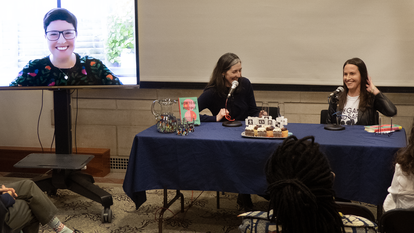Wellesley Anthropology Project on the Former Site of College Hall Yields a Surprising Find

When Elizabeth Minor ’03, Mellon post-doctoral scholar in anthropology at Wellesley, and her students from ANTH 252 The Archaeology of Wellesley conducted an anthropological excavation in the courtyard of Tower Court, they thought they would unearth buried debris from the 1914 College Hall Fire, which destroyed the original building that was located on the grounds. But they found something they didn’t expect.
Near the sundial in Tower Court, buried beneath more than two feet of ash, melted glass, and dirt, they found three skull fragments no larger than a silver dollar.
“Our team found fragments of an anatomical skeleton that was part of the pre-1914 teaching collection,” said Minor. “They have distinctive curves and textures that told us that they are from a human.” She also noted that the dig area was not a disturbed burial site “as the fill is full of ash from the fire so that we know anything found in it is from that one destructive event.”
Associate professor of anthropology Adam Van Arsdale identified the fragments in part because of specific markings that show they were used for physiological education. According to Minor, “The fragments all have marks that show they were modified by a saw or drill, so they are from an anatomical specimen.” The modification match the skeleton in the archival photo but Minor isn’t certain it is the same one.
The area where the fragments were unearthed is in the former area of the College Hall Atrium, below a natural history display that existed at the time of the fire. The dig on top of Severance Hill turned up a trove of other science-related instructional debris.
“We found geological mineral samples, including kyanite crystals that are distinctive and not usually found in nature in such a close-together area,” Minor explained. “Some geode fragments had glass melted onto them, which suggests they were mineral samples in a glass case for instruction in a classroom.”
From the evidence, Minor said the fire, which totally destroyed College Hall, burned so hot that it caused the upper floors, which included science classes, to collapse like a “pancake” on top of lower levels and collapse to the ground.
Minor credits the Wellesley College Police, the Massachusetts State Examiner’s Office, and the state Archaeology Department in helping her process the fragments under local protective regulations.
As part of her classes, Minor and her students dig for fragments of student belongings, classroom equipment, and architecture, many of which are more than 100 years old. Students then identify and explore research questions about experiences, culture, and daily life of the Wellesley community from that time period. Minor hopes to have her students curate a display of artifacts in the fall.
Photo: In this archival photo taken about 20 years before the 1914 College Hall Fire, Wellesley College students work in a lab with anatomical skeletons similar to those used in physiology classes where the archeology project’s skull fragments were found.



